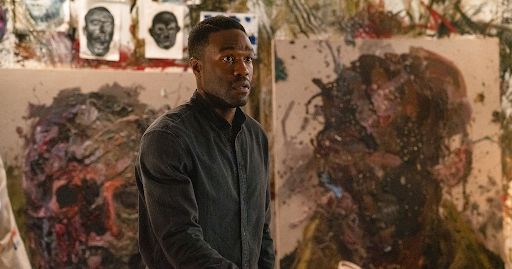Nia DaCosta’s “Candyman” has opened in theaters and is being marketed as a direct sequel to the 1992 film of the same name, while making the smart decision of completely ignoring prior sequels “Candyman: Farewell to the Flesh” (1995), and “Candyman: Day of the Dead” (1999). The sequel was directed by DaCosta, who wrote the screenplay alongside “Candyman” producers Win Rosenfeld and Jordan Peele, who previously directed horror films “Us”(2019) and “Get Out” (2017). With the addition of a great cast and crew, this movie did not disappoint.
The story follows artist Anthony McCoy (Yahya Abdul Mateen II) who lives in Chicago with his girlfriend Brianna (Teyonah Parris). After learning about the urban legend of Candyman from Brianna’s brother Troy (Nathan Stewart-Jarret), McCoy is inspired to create art for the first time in a while. McCoy meets an old tenant, William Burke, and learns more stories about the Cabrini Green projects that Candyman would haunt and the effect it had on its residents. As McCoy takes a nosedive into his art and learns more of the myth of Candyman, more people are murdered at the hands of the malevolent spirit. Eventually, McCoy succumbs to madness with his discoveries of the paranormal.
Yahya Abdul Mateen II gives a brilliant performance and truly shines as a leading man. He is able to completely immerse his body into the role with the help of prosthetics, but his acting still stands out. In certain scenes, Mateen makes erratic and bewildered expressions that truly make the audience question the sanity of the character.
DaCosta’s direction and writing lend the film a new level of horror and surprise audiences by flipping tropes on their head. Creepy basements are ignored and none of the Black characters, typically the first to die, are killed by Candyman. DaCosta shows that true horror comes from the very real experiences of the Black community being abused and ignored, similar to Jordan Peele’s other films. Men who have become Candyman throughout the years were all people who weren’t given proper justice, whether that was because of lynchings, police shootings or other types of violent discriminatory behavior. Candyman in the end results as more of an anti-hero than a true villain. Serving as both a murderer and a protector Candyman becomes a conduit for the anger and pain of the Black community of Cabrini Green.
The unique way the film approached Black pain and injustice was both respectful and captivating, especially when we consider the long history of the horror genre glamorizing black pain. Dacosta didn’t glamorize harsh realities, instead, she showed that sometimes pain can also be a strength.





